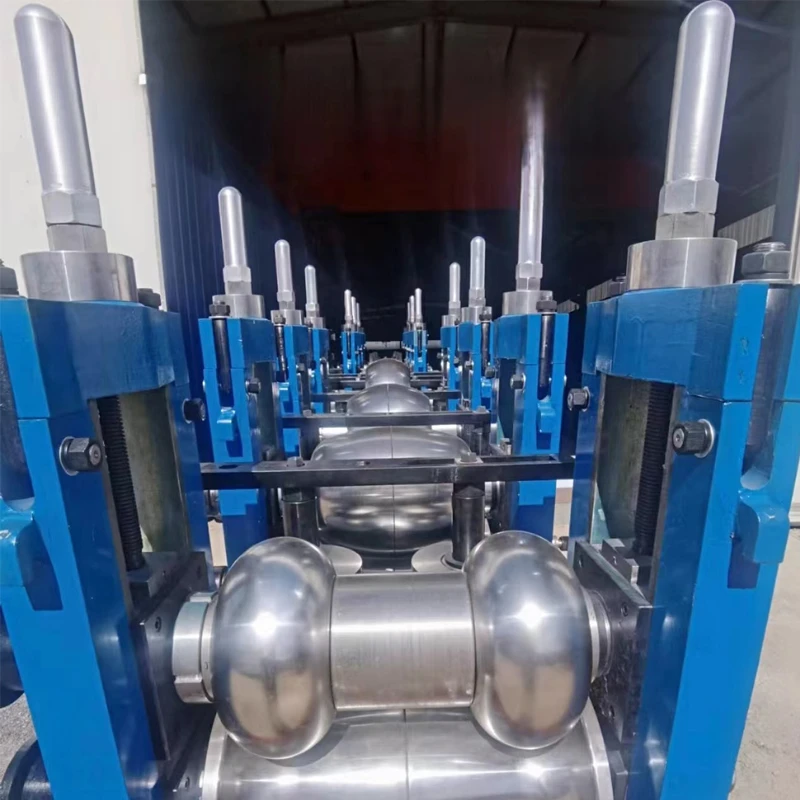rolling mill flying shear
Understanding the Rolling Mill Flying Shear Process
In the metalworking industry, rolling mills play a crucial role in shaping and sizing metal products. Among the various processes involved, flying shear is a sophisticated technology that enhances the efficiency and accuracy of metal cutting during rolling operations. This article delves into the intricacies of the rolling mill flying shear process, elucidating its functionality, advantages, and impact on modern metallurgy.
What is a Rolling Mill?
A rolling mill is a type of industrial facility actively used in the manufacturing processes of metals. It comprises a set of rollers that shape the metal into desired forms such as sheets, strips, and bars. The primary goal is to reduce the thickness of the metal while increasing its length through mechanical deformation. Rolling mills are equipped with various subsystems, including the flying shear apparatus, which is critical for achieving high production rates and operational efficiency.
The Role of Flying Shear in Rolling Mills
Flying shear is a cutting mechanism used in rolling mills to precisely cut metal products into desired lengths while they are still in motion. Unlike traditional shears, which operate in a stationary manner, flying shear functions dynamically, aligning its cutting action with the speed of the rolling material. This synchronization is vital because it allows for continuous operation without interrupting the flow of production.
How Flying Shear Works
The flying shear mechanism consists of several key components the shear blade, the transport system, and the control system. As the metal passes through the rolling mill, it reaches a predetermined point where the flying shear is activated. The shear blade, designed to slice through the metal quickly, is propelled forward at high speed, ensuring a clean cut. The transport system then carries the cut length away for further processing.
One of the significant aspects of flying shear technology is its ability to accommodate different materials and thicknesses. Advanced control systems enable precise adjustments to the shear's operation based on real-time measurements of speed and thickness, making the system adaptable to varying production needs.
Advantages of Flying Shear Technology
rolling mill flying shear

1. Increased Production Efficiency By cutting metal on-the-fly, flying shear minimizes downtime associated with traditional cutting methods. This leads to a more streamlined production process and higher output rates.
2. Enhanced Precision Flying shear provides an exceptional level of precision when cutting. The automated controls ensure that each cut is consistent in length and quality, minimizing waste and reducing rework costs.
3. Improved Material Handling The ability to cut metal while it is still moving reduces the need for complex handling and transfers, thereby simplifying the production workflow.
4. Reduced Labor Costs With automation at the forefront, flying shear systems require less manual intervention, leading to reduced operational costs and allowing workers to focus on more critical tasks.
Challenges and Considerations
Despite its myriad advantages, implementing flying shear technology in a rolling mill presents several challenges. The initial investment for advanced machinery can be significant. Additionally, the complexity of the system requires skilled operators for setup and maintenance.
Moreover, the dynamic nature of the flying shear presents the need for regular calibration and monitoring to ensure optimal performance. Continuous advancements in technology necessitate adaptation and upgrades, which can be resource-intensive.
Conclusion
The rolling mill flying shear process stands as a pivotal advancement in the metallurgy industry, significantly enhancing production efficiency, precision, and material handling. As manufacturers seek to optimize their operations and reduce costs, flying shear technology becomes increasingly relevant. While challenges exist in terms of investment and operational complexity, the benefits far outweigh the drawbacks, making flying shear an essential component of modern rolling mills. As technology continues to evolve, further improvements are expected to enhance its capabilities, solidifying its place in the future of metal processing.
-
High Frequency Straight Seam Welded Pipe Production Line-BzZhou Xinghua Machinery Equipment Manufacturing Co., LTD.|line pipe steel&welded gas pipeNewsJul.30,2025
-
High Frequency Straight Seam Welded Pipe Production Line-BzZhou Xinghua Machinery Equipment Manufacturing Co., LTD.|High Precision&Automated SolutionsNewsJul.30,2025
-
High Frequency Straight Seam Welded Pipe Production Line - BzZhou Xinghua Machinery Equipment Manufacturing Co., Ltd.NewsJul.30,2025
-
High Frequency Straight Seam Welded Pipe Production Line-BzZhou Xinghua Machinery Equipment Manufacturing Co., LTD.|Precision Welding, High EfficiencyNewsJul.30,2025
-
High Frequency Straight Seam Welded Pipe Production Line|BzZhou Xinghua|Precision Welding&EfficiencyNewsJul.30,2025
-
High Frequency Straight Seam Welded Pipe Production Line - BzZhou Xinghua|Precision Engineering&EfficiencyNewsJul.30,2025


